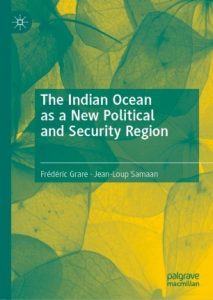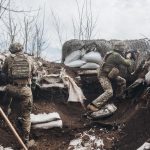
“The new Indian ocean is neither solely the battleground of a strategic triangle between the US, India, and China nor a vast space of competition among the local players, rather it is both.” (Grare and Samaan 2022)
Indian Ocean Region is a vast water body that includes from the Western Coast of ASEAN to the Eastern coast of the African continent. The huge water body covers around 51 coastal and landlocked states with various trade routes passing through this region. This area is rich in minerals and flora/ fauna with about one-third of the world population. Thus, it becomes one of the most widely contested areas by the world’s powerful nations.
About the book-
‘The Indian Ocean as a new Political and Security Region’ by Jean-Loup Samaan and Frederic Grare is the latest book published on the Indian Ocean Region (IOR) which describes the various stakeholders that play an important role in defining the regional geopolitics of IOR. We understand in international relations, there is a constant change in political and security discourse in the regional dynamics. So, this book gives the reader a comprehensive and analytical understanding of the changing dynamics of IOR and provides an explanation of the contemporary changes that have affected the regional dynamics like the COVID-19 crisis, the Galwan standoff, and the change in US Administration.
Chapterisation
The book is divided into nine chapters that include the various participants that have stakes in the region and also describe what the future holds for the IOR with growth in development in the third world, mainly the East African nations.
Chapter 1 – The book starts by acknowledging that the Indian Ocean has long been a ‘neglected ocean’ with respect to other centers of world power. It was long been not given the utmost priority as a potential hub for economic growth as the region was politically fragmented and no major world power emerged from this region that can carve out its economic potential. The scholars too understood that the IOR is too broad to be clustered under a common geopolitical context. This understanding though faded away with the turn of the 21st century with the true economic rise of India and China, two Asian powerhouses that rely on the Indian Ocean largely for their economic growth. The book argues too on the absence of a powerful security architecture that has access to the Pan-Indian Ocean. The Indian Ocean Rim Association (IORA), the Indian Ocean Naval Symposium, and ASEAN Regional Forum are only such organization but don’t have such definitive forces to create a security architecture under a common platform. The region comes in limelight much since 2008 when piracy attacks in maritime trade routes grew aggressively and this made the US the only established maritime power in IOR inviting regional powers like China and India to partner in counter-piracy operations. China has since then grown in its maritime stature by deploying its naval power and also developed its own offshore naval base in Djibouti.
Chapter 2 – This chapter introduces how China through its BRI and Maritime Silk Road Project have unified the various developing countries in the region but also created a polarized atmosphere at the same time by influencing these small nations via debt traps and increasing its naval capabilities by acquiring multiple bases. The BRI has created a series of alignments that have created an atmosphere for unifying the region which was absent before. The book speaks on a new geographical contextualization called ‘Nareland (Natural Resources Land)’ articulated by Indian analyst Raghavendra Mishra that defines China’s seek for dominant access to natural resources and influence in IOR.
Chapter 3 – The author describes India’s developed role in the region and the unease it feels due to the growing influence of China in the region. This resulted in India’s development mainly in IOR through political and economic investments in small nations like Seychelles, Mauritius, Maldives, and Mozambique as these are located on the transit routes of the region. It also talks about India’s growing resemblance of becoming a major power through engaging with powers like Japan, France, and US in order to mitigate China’s influence in East Africa and South East Asia. The policies like SAGAR and IONS are leading mechanisms for India’s engagement. The author also highlights India’s shortfall in challenging China’s influence in the region but sees it as the only partner of choice that can mitigate the impact of China’s rise.
Chapter 4 – This chapter discusses the role of extra-regional powers like the US, the EU (France and the UK) in the subsequent chapters of the book. The author agrees the US still being the most powerful player and the most important military power in the region. US policies in the region are much broader that cover the whole Indo-Pacific, in which it tries to contain the growth of China and maintain a strong influence with like-minded countries. He further argues that the security aspect of IOR for the US is primarily an extension of the developments originating from the Asia-Pacific where ASEAN is central to the policy formation, whereas it also feels India be the central power to lead in the Indian Ocean.
Chapter 5 – The other powers like France and UK have substantial influence in the region, as France has significant EEZs that it controls in the Western and Eastern Indian Ocean and the UK though have given up its bases long back to the East of the Suez Canal but its frequent naval expeditions and trade dynamics makes it among the interesting extra-regional powers of IOR. These middle powers understand that IOR has over time become central to international trade and the security of the region is paramount for securing its economic growth.
Chapter 6 – Gulf countries hold the major share of oil reserves in the region and developed their economic potential through foreign investments and maintaining a favorable foreign policy with the other regional and extra-regional powers in the region. The author understands the potential of players like UAE, Qatar, and Saudi Arabia to be the future powerbrokers in the region which will consider asserting its position mainly in the strategic chokepoints in their backyard, East Africa and its peripheral region.
Chapter 7 – The book also discusses the change in Australia’s perception of the IOR since it understood China’s assertive growth and intentions for the region. Australia and the ASEAN countries have developed similar sentiments toward the Chinese expansionism formula but they understand that hedging is only what they can persist in against revisionist power like China. They are pushing regional powers like India to balance the rise of China in the region and being lately engaged by adopting strategic and security cooperation with India as viable options.
Chapter 8 – Africa is the least considered in the contemporary strategic culture of IOR, as it is still reeling through internal civil wars and development has not yet fully reached its shores. But the author addresses that East Africa is a major priority for the Indian Ocean as it has reserves for natural resources that has not yet been fully exploited. Regional powers like China and India have developed their relations with these countries for the development of infrastructures.
Chapter 9 – In the final chapter, the book describes the potential of smaller regional players and the external powers arguing that the crucial challenge for the region is to turn the economic and military capacities of these nations into instruments of governance, instead of tools for the competition which will eventually turn the Indian Ocean into a future battleground. China’s growth has changed the dynamics of IOR, but the central issue is no longer the naval dominance of China or India per se, nevertheless, it includes comprehensive maritime security in which there is a need to address the predatory practices combines with the need to manage the growing militarization of the region that includes protection of EEZs, and the need for a constructive security architecture.
Analysis
The author argues on the ‘emerging multipolarity’ as an important aspect of the evolving characteristics of Indian Ocean Region. Previously it was only the US that have had presence as a powerful entity in the IOR. But with the rise of India and China, the security complex has increased with multipolar characteristics in the region. It’s not only the ‘strategic triangle’ of this three that characterizes the Indian Ocean multipolar order, but other regional and extra-regional powers have stakes also in the region like the US, Japan, Russia, France, UK, and parts of the East African region. The author suggests that the specific rise of China and its exponential growth all over the IOR, especially on the military and economic front has generated a growth in fight for strategic presence in the region and emerging of a new arms race. The ‘String of Pearls’ and ‘Maritime Silk Road’ project are special mentions to China’s growing footprints in IOR. The author also characterizes India’s increased role as a regional power in the IOR after 2014 with inauguration of Narendra Modi as the new Prime Minister, as India accelerated its plans to build stronger ties with partners in the region including the Persian Gulf, Southeast Asia and Africa. US and other extra-regional powers play equally important role in shaping of the future of this vast geographical maritime space.
Recommendations
The book revolves around the two modern-day Indian Ocean competitors, India and China, where China plays the role of a revolutionist as well as a revisionist power in the IOR. Whereas, India is still an evolving power in the region that is expected to balance China’s growth in Asia. The book is easy to read as the language and vocabulary used in the chapters are in common terms the academic scholars and students of political science and similar streams. This is also a must-read for the policymakers who can add value to their knowledge by going through the book. Also, further research on the IOR is possible by incorporating valuable insights from the book.
Conclusion
This book is the latest piece on the Indian Ocean geopolitical understanding, where it gives an insight into the power competition between the three important stakeholders China, the US, and India. It also gives an understanding of the challenges for security growth and maintaining a peaceful regional dynamic.














